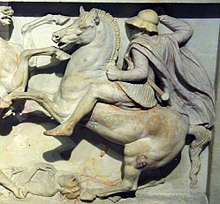Boeotian helmet

TheBoeotian helmetwas a type ofcombat helmetused inAncient Greeceduring theclassicalandHellenisticperiods, as well as inAncient Rome;it possibly originated in the Greek region ofBoeotia.
Characteristics[edit]

The Boeotian helmet was modelled on the shape of a folded-down Boeotian variant of thepetasos,a type of Greek sun hat, usually made offelt.[1]As an open helmet, it allowed good peripheral vision and unimpaired hearing. It had a domed skull surrounded by a wide, flaring, down-sloping brim. The brim came down at the rear to protect the back of the neck, projected forward over the forehead and was worked into a complex shape at the sides, with downward pointing folds affording some lateral protection to the face. A long falling plume was sometimes attached to this type of helmet. The need for unimpeded vision and good hearing was particularly acute forcavalrymen,therefore this type of helmet was used primarily by mounted troops.[2]
This type of helmet was beaten from a single sheet of bronze using a helmet-shaped "former," one of which, made of limestone, is extant. An excellently-preserved example of a Boeotian helmet, which may have belonged to one ofAlexander the Great's cavalrymen, was recovered from theTigris RiverinIraq,and is now in theAshmolean Museum.In the late Hellenistic period, the helmet evolved into a type with a taller, more conical skull and often a reduced brim.[3]
Use[edit]

The Athenian military expert and authorXenophonparticularly recommended the Boeotian helmet for cavalry, saying "...the Boeotian type [of helmet]. For this not only gives the greatest protection to all the parts above the cuirass, but allows free vision."[4]This piece of advice was taken up byAlexander the Great,who equipped his cavalry with this helmet.[5]Both theAlexander Sarcophagusand theAlexander Mosaicshow cavalrymen of theAncient Macedonian armywearing Boeotian helmets.[6]As a specialised cavalry helmet, its use was not as widespread as some other ancient helmets such as theCorinthianorPhrygiantypes.
This helmet continued to be used by the successors of Alexander the Great, likely throughout the Hellenistic world, but especially in theGreco-BactrianandIndo-Greek kingdomswhose rulers often wore a variant of the helmet and even featured them on their coins.[7]This was a very unusual and rare practice as most Hellenistic kings were shown wearing only the royaldiademson their coins.
The helmet was also used by Roman citizen cavalry in theRepublicanperiod. On thealtar of Gnaeus Domitius Ahenobarbus(aconsulin 122 BC), a Roman cavalryman is depicted wearing it with the later more conical skull and furnished with a falling horsehair plume.
The naming conventions and typology of ancient helmets are largely of modern origin and do not reflect contemporary usage.[8]The term "Boeotian helmet", however, is an exception since it was employed by Xenophon and is therefore of contemporary usage. Another piece of martial equipment linked to the region of Boeotia is theBoeotian shield;however, no surviving examples have been found, and its association with the region is largely through depictions on local coinage.
Gallery[edit]
-
Coin ofEucratides Iwearing a crested Boeotian helmet, decorated with bull's horn and ear; c. 171–145 BC.
-
Indo-Greek kingHermaeuswearing a similar helmet, depicted on one of his silver coins; c. 90–70 BC.
-
A Boeotian helmet found in the Tigris river, seen from a different angle showing damage.
References[edit]
- ^Sekunda 2002,p. 69.
- ^Anderson 1961,pp. 147–148.
- ^Connolly 1998,p. 73.
- ^Xenophon.Hippike,XII.3;Fraser 1922,p. 99.
- ^Anderson 1961,p. 147.
- ^Connolly 1998,p. 72.
- ^"Eucratides | King of Bactria & Greco-Bactrian Empire | Britannica".britannica.Retrieved2024-07-11.
- ^Connolly 1998,p. 60: "Terms such as 'Illyrian' and 'Attic' are used in archaeology for convenience to denote a particular type of helmet and do not imply its origin." )
Bibliography[edit]
- Anderson, John Kinloch(1961).Ancient Greek Horsemanship.Berkeley and Los Angeles: University of California Press.
- Connolly, Peter(1998).Greece and Rome at War.London: Greenhill Books.ISBN978-1-85367-303-0.
- Fraser, A.D. (1922). "Xenophon and the Boeotian Helmet".The Art Bulletin.4(3): 99–108.doi:10.2307/3046411.JSTOR3046411.
- Sekunda, Nick(2002).Marathon 490 BC: The First Persian Invasion Of Greece.Oxford: Osprey Publishing.ISBN978-0-27-598836-4.
External links[edit]
 Media related toBoeotian helmetsat Wikimedia Commons
Media related toBoeotian helmetsat Wikimedia Commons



